Llanfrynach is a village and community in the ancient county of Breconshire, which lies just to the southeast of Brecon in the Brecon Beacons National Park. The village sits astride the Nant Menasgin, a right bank tributary of the river Usk. The B4558 passes just to its north and the Monmouthshire and Brecon Canal also passes around the village. The men of the village who fell during the Great War are commemorated on a wooden war memorial which is located inside St. Brynach’s Church. Also inside the Church, among other memorials, is a brass memorial plaque to a woman who died during the Great War.
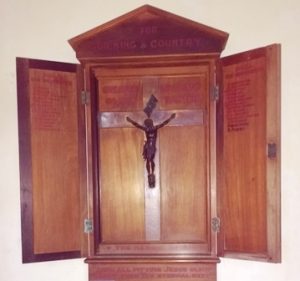
The Great War, 1914-1918
Alice Maude Mary Starkie Bence, Volunteer. Alice was born on 29 April 1868, the daughter of Captain Edward Robert Starkie Bence and Eliza Charlotte Albinia Bence (nee Sullivan), of Kentwell Hall, Long Melford, Suffolk. As a young woman, she became well-known in society as being a professional golfer and was a family friend of Lord Glanusk. The family had a long-standing relationship with the South Wales Borderers, with many of the men serving as officers in the famous regiment. As a result, following the outbreak of war, Alice left Suffolk to take up residence at Llanfrynach and set up the South Wales Borderers Comforts Scheme, the County War Committee and the Breconshire Motor Service Organisation, working from County Hall, in Brecon. She worked tirelessly over the first months of the war, but the stress of her work led to her health breaking down and she was hospitalized at the Priory, Folkestone. Sadly, she died there on 1 July 1916, aged 48. Her remains were brought back to Llanfrynach, and she was laid to rest in St. Brynach’s Churchyard. Following her death, the officers of the 1st Battalion, South Wales Borderers erected a brass plaque in her memory within St. Brynach’s Church in October 1917. Alice is not commemorated on the main war memorial.
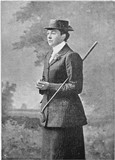
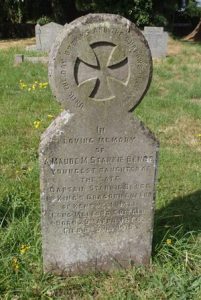
John Harris, Private, 99087, Machine Gun Corps. John was born in 1897, the son of George Harris and Susan Harris (nee Davies), of Mountain View, Llanfrynach. He worked on his parents farm at Llwyncelin prior to the war. John originally enlisted at Brecon into the South Wales Borderers, but upon completing his training, became a specialist machine-gunner and was posted to the 9th Battalion, Machine Gun Corps. The battalion was formed at Haut-Allaines in France on 1 March 1918 from the four Machine Gun Companies of the 9th (Scottish) Division. The division was at the time holding a sector of the front line near Gouzeaucourt, and the 9th Battalion, MGC set up its HQ at Nurlu, with its four Companies set up along the divisional front. At dawn on 21 March 1918 the section of Western Front running south from Croisilles to La Fre was subjected to a terrifying artillery bombardment, which was followed up by a massed assault by hordes of German stormtroopers. Codenamed Operation Michael, this was the first of three planned offences for the spring of 1918. The Germans totally overwhelmed many of the Allied units holding the front line and began to drive the Allies back towards the old Somme battlefields of 1916. The 9th Division took part in a stubborn rear-guard action over the coming days before the survivors reached Mericourt-L’Abbe and reorganized its defences behind the river Ancre to the south of Albert. The tired division was relieved at the end of the month and transferred north to the quieter Lys sector, to rest and rebuild, taking over positions in front of Mount Kemmel, in the southern part of the Ypres Salient. At dawn on 9 April 1918, the Germans launched the second phase of their offensive, codenamed Operation Georgette, along the Lys valley, attacking a sector held by Portuguese Troops, who broke and fled. The 9th Division was one of several ordered forwards to plug the gap in the lines and heavy fighting soon erupted. John was reported missing during a day of heavy fighting on 16 April 1918. He was later found to have been taken prisoner by the Germans and was reportedly being held in Germany. He was in fact being held at a POW Camp in the Ardennes. Sadly, John took ill during his time in captivity and died of heart disease in hospital at Charleville on 3 October 1918. The 21-year-old was originally buried by the Germans in Charleville Communal Cemetery, in the Ardennes, but in December 1962 the war graves within the cemetery were exhumed and re-interred in Terlincthun British Cemetery, Wimille, France.
William Lorimer Joyce, Private, 26741, South Wales Borderers. William was born in 1885, the son of William Joyce and Jane Joyce (nee Johnson), of the White Swan Inn, Llanfrynach. He had left home by 1911 and was lodging at Churchill, near Kidderminster, where he worked as a gardener. William returned home to enlist into the 3rd Battalion, South Wales Borderers in the spring of 1915. Upon completing his training, he was drafted to the Mediterranean to join the 4th Battalion, South Wales Borderers, which was in Egypt attached to 40 Brigade, 13th (Western) Division. The division had been evacuated from Gallipoli in January 1916, then on 15 February 1916 embarked at Suez, arriving at Basra on 4 March to join the forces being assembled to attempt to relieve the besieged garrison of Kut-al-Amara. The garrison at Kut fell to the Turks soon afterwards, and the British built up a force, the MEF, in preparation to drive the Turks out of the country. The began a long an arduous campaign, in hostile countryside which saw more men succumb to sickness and disease than to the fighting itself. William was posted as missing during the Mesopotamian campaign and was later deemed to have died there on 2 October 1917. The 32-year-old has no known grave and is commemorated on the Basra Memorial, Iraq.
William Edwin Morgan, Private, 27794, South Wales Borderers. William was born in Llanspyddid in 1898, the son of William Morgan and Annie Eleanor Morgan (nee Price). By 1902 the family had moved to Church Road, Llanfrynach and William worked as a newsboy. Prior to the war the family moved to Avenue Court, Brecon, then William left home to work for the Brecon and Merthyr Railway in Machen. He enlisted at Brecon into the 2/1st Brecknockshire Battalion, South Wales Borderers soon after the outbreak of war. William was posted to Bedford to join the battalion, then after completing his training was drafted to the Middle East on 3 July 1915, to join the 1st Brecknock Battalion at Aden. Soon afterwards the Brecknocks were transferred to India, to serve as garrison troops, but William wanted to see action, so he voluntarily transferred to the 4th Battalion, South Wales Borderers. The battalion was in Mesopotamia, attached to 40 Brigade, 13th (Western) Division and had been sent there to help in the attempt to relieve the besieged forces of General Townshend at Kut. William was killed in action during the drive on Baghdad on 30 April 1917. The 19-year-old has no known grave and is commemorated on the Basra Memorial, Iraq.
Hubert Stanley Cadogan Ogleby, Engine Room Artificer 4th Class, M/6188, Royal Navy. Hubert was born on 4 December 1890, the son of Henry George Ogleby and Martha Ogleby, of Connaught House, Pembroke. He married Florence Grace Joyce, of Manascin, Llanfrynach at Llanfrynach Church in 1915. Hubert served in the Royal Navy, and by 1918 was serving aboard HMS Vehement, a destroyer that had been converted for minelaying duties, and was attached to the 20th Destroyer Fleet. On 1 August 1918, the Fleet sailed from the Humber to lay a minefield at the seaward end of one the German-swept channels through their minefield in the Heligoland Bight. It was almost midnight when Vehement struck a mine which exploded her forward magazine and blew off the whole forward section of the ship. She was later sunk by gunfire from Telemachus and Vanquisher. Hubert was one of 48 men killed in the explosion. The 27-year-old has no known grave and is commemorated on the Plymouth Naval Memorial, Devon. He is commemorated on the St. Michael’s war memorial in Pembroke and on his parents grave at Pembroke.
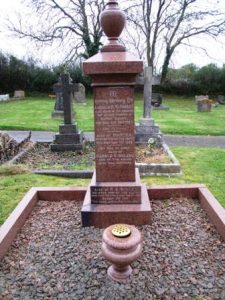
David Richard Price, Private, 15610, Monmouthshire Regiment. David was born on 10 October 1897, the son of Evan Price and Frances Price (nee Evans), of The Lamb Inn, The Watton, Brecon. By 1911 the family was residing at Gardener’s Cottage, Dinas, Brecon after his father had become head gardener at Ffynnonau. David enlisted at Brecon into the Monmouthshire Regiment soon after the outbreak of war and was drafted out to France during the early weeks of 1916, joining the 2nd Battalion, Monmouthshire Regiment. On 30 January 1916 the 2nd Monmouth’s were put on Lines of Communication, then on 1 May 1916 joined the 29th Division, which had arrived from Egypt, becoming the Divisional Pioneer Battalion. The Division suffered terrible casualties at Beaumont Hamel, during its assault on Y-Ravine on 1 July 1916 and, although severely depleted, the Division remained in the line here over the coming weeks, in trying conditions. David was wounded by shrapnel during the early stages of the Somme offensive but returned to duty soon afterwards. On 27 July the Division entrained for Flanders, detraining at Proven before relieving the 6th Division at Ypres. The Division held the line here over the coming weeks as it rebuilt its strength and the 2nd Monmouth’s worked hard on improving trenches and digging new communications trenches. The battalion then worked on the Menin Road, erecting elephant shelters, then on 4 October the Division was relieved and entrained south for the Somme once more, moving to Trônes Wood, before joining the latter stages of the Somme offensive. The Division wintered on the Somme, with the 2nd Monmouth’s working on road repairs around Montauban. During the early hours of 23 November 1916, the men of the 2nd Monmouth’s were in their billets at Montauban when the camp was hit by enemy artillery fire. Despite this, the men were put to work as usual, with parties of men digging a new trench from Ginchy. David was killed when his working party was hit by enemy shellfire later that day. The 19-year-old was buried in A.I.F. Burial Ground, Flers, France.
Morgan John Walters, Private, 27822, South Wales Borderers. Morgan was born at Llangasty in 1888, the son of William Walters and Eliza Walters (nee Price). The family later moved to East View, Llanfrynach. Morgan worked as a carpenter prior to the war and was a long serving member of the local Territorial army unit, the Brecknockshire Battalion, South Wales Borderers, having enlisted on 3 April 1908. Morgan had attended the annual TA summer camps at Porthcawl, Aberystwyth and Haverfordwest over the coming years. Following the outbreak of war, he re-joined the Brecknock Battalion, South Wales Borderers, and was posted to Pembroke Dock to join the reserve battalion. He was drafted to the Middle East on 3 July 1915, to join the 1st Brecknock Battalion at Aden. Soon afterwards the Brecknocks were transferred to India, to serve as garrison troops, but William wanted to see action, so he voluntarily transferred to the Devonshire Regiment before being posted to the 4th Battalion, South Wales Borderers. The battalion was in Mesopotamia, attached to 40 Brigade, 13th (Western) Division and had been sent there to help in the attempt to relieve the besieged forces of General Townshend at Kut. Morgan was killed in action in Mesopotamia on 30 April 1917. The 29-year-old has no known grave and is commemorated on the Basra Memorial, Iraq.
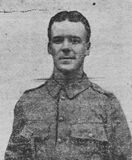
Stephen Williams, Lance Corporal, 17679, Cheshire Regiment. Stephen was born in 1894, the son of David Williams and Anne Williams (nee Stephens), of The Post Office, Llanfrynach. Stephen left home as a young man and by 1911 was lodging at 30, Duffryn Street, Pontlottyn, where he had found work as a colliery labourer. He enlisted at Bargoed into the army soon after the outbreak of war and was posted to the 9th Battalion, Cheshire Regiment. The battalion formed at Chester in September 1914, moving to Salisbury Plain to join 56 Brigade, 19th (Western) Division. In March 1915 the division moved to Salisbury Plain to complete its training, then on 19 July 1915 Stephen landed at Boulogne with his battalion, before the entire division moved to the Festubert area for trench initiation. The division took part in a diversionary attack near Festubert on 25 September 1915 and suffered heavy casualties for no gain. It wintered in the same sector, before heading south to the Somme sector in the spring of 1916 and on 2 July 1916 joined the great Somme offensive, as part of the second wave of the attack on Ovillers and La Boiselle. Stephen was badly wounded during the early stages of the Somme offensive and after treatment in France was invalided back to Britain. Upon recovering, he was drafted back out to France on 6 January 1917, and was transferred to the 15th Battalion, Cheshire Regiment, which was attached to 105 Brigade, 35th Division. The Division had just completed a lengthy refit before going back into the line and followed the German Retreat to the Hindenburg Line in March 1917. Later in the year the division moved north to Ypres and fought at the Second Battle of Passchendaele. After Christmas 1917, the 15th Cheshire’s moved out of the line to a training school near Poperinghe, then moved back to Elverdinghe before moving into support positions at Poelcapelle on 16 January. Stephen was killed in action during this routine spell in the line, on 20 January 1918. The 24-year-old is buried in Minty Farm Cemetery, Belgium.
Those Who Served and Returned
In addition to the men above, the names below which are on the Llanfrynach war memorial are of those who served and returned home safely. They are in order of how they are on the two memorial panels, and are not alphabetical. Those who fell are prefixed on the memorial with the + symbol:
J. Jones
H. Powell
Walter Walters
Henry Jones
Wm. Jones
+D.R. Price
+S. Williams
+M. J. Walters
J. Carter
W.J. Evans
A. Turner
T. Evans
H. Griffiths
W. Griffiths
A. Skyrme
+Wm. Joyce
G. Shaw
Sid. Price
+John Harris
+Wm. Morgan
Edward Jones
Wm. Evans
+H.C. Ogleby
Stanley Davies
J. Steele
Evan Jones
R. Parry.